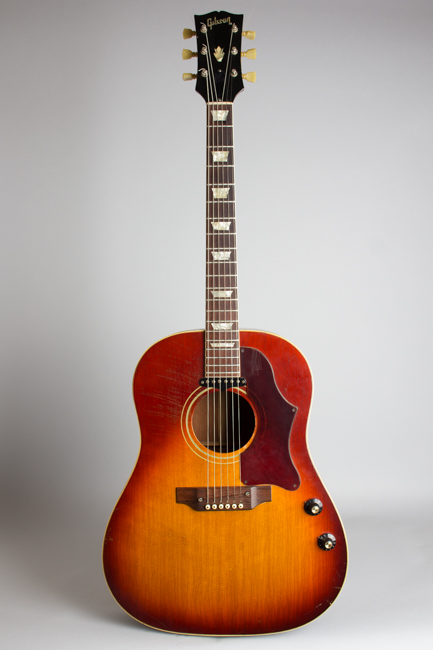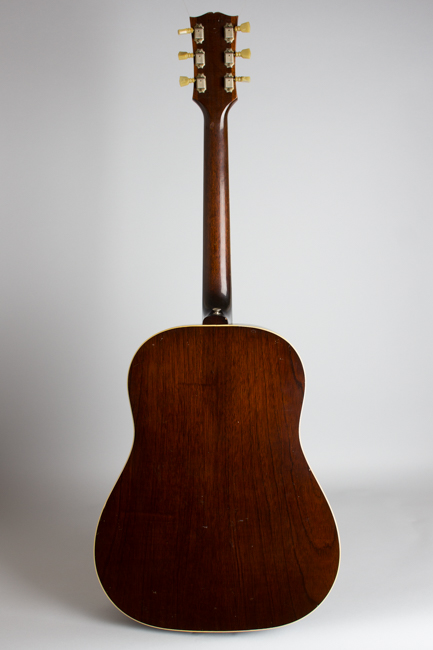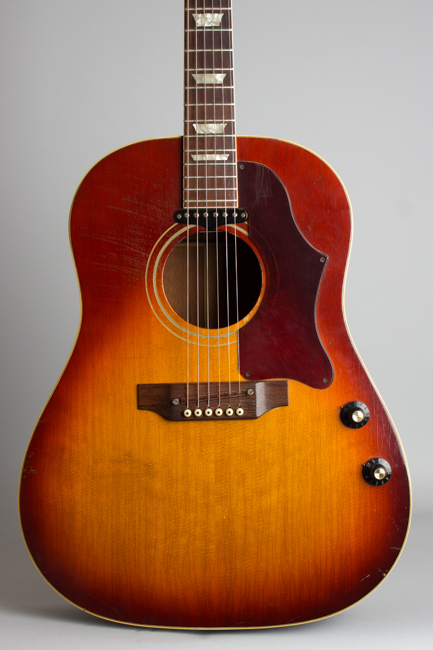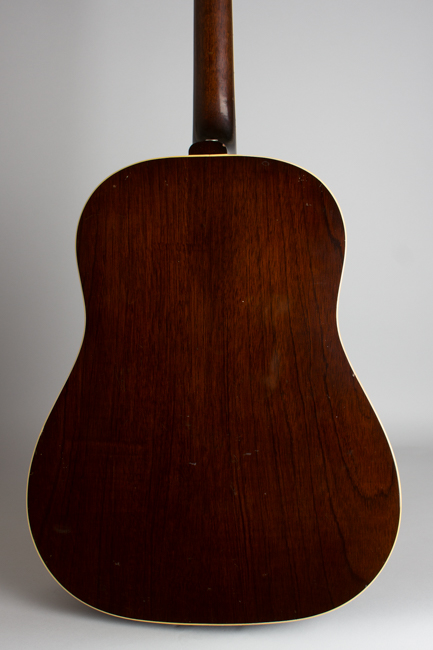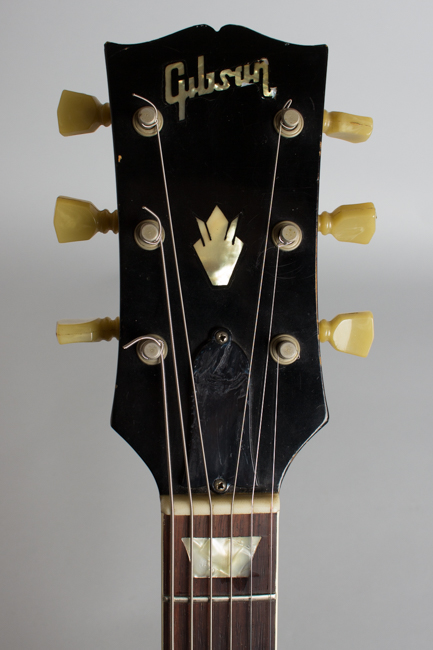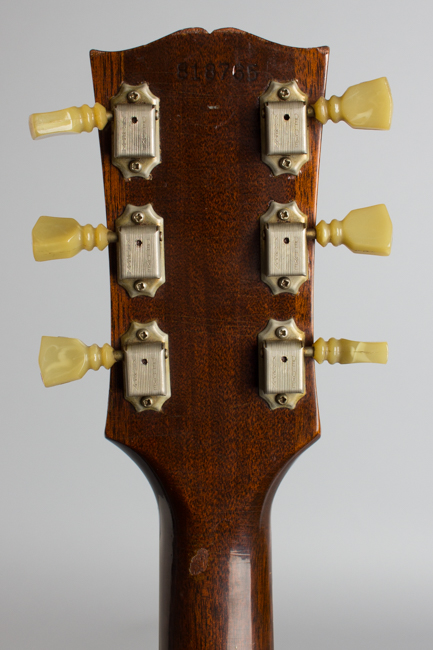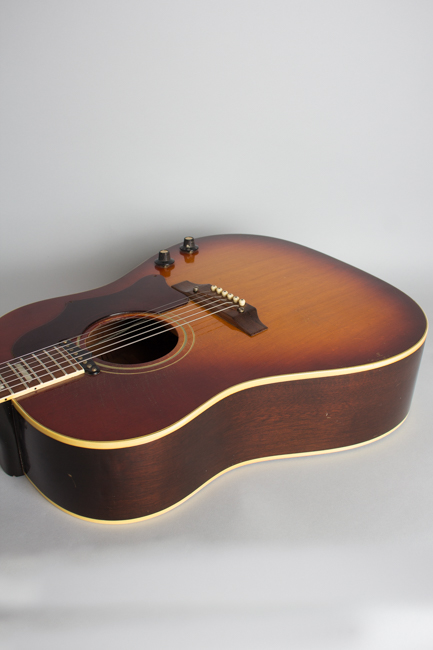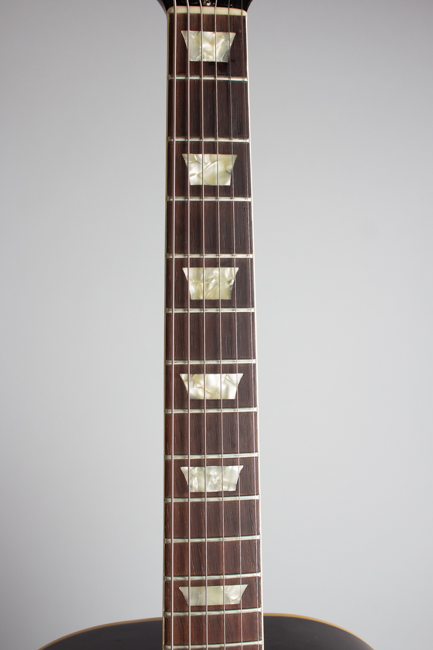Gibson J-160E Flat Top Acoustic-Electric Guitar (1969)
This item has been sold.
Item # 8105
Prices subject to change without notice.
Gibson J-160E Model Flat Top Acoustic-Electric Guitar (1969), made in Kalamazoo, Michigan, serial # 818765, sunburst top, dark back and sides finish, mahogany back, sides and neck; spruce top, rosewood fingerboard, black hard shell case.
Gibson's J-160E electrified flat-top was a fairly successful guitar in its time, but is now remembered primarily as one of the iconic "Beatle guitars" of the 1960s. John Lennon and George Harrison both used J-160Es as recording and touring instruments extensively during the band's early '60s breakthrough period, and this particular Gibson model remains indelibly linked to the Beatles' legacy both visually and sonically.
The J-160E was originally of the more specialized Gibsons of the 1950s. Designed specifically for country/Western performers getting drowned out by their increasingly well-amplified bands, the fairly fancy 16" Jumbo sported the same electronics (a specially adapted P-90 pickup) and cosmetic features as the earlier small-body CF-100E. Unlike that guitar (and all other period Gibson flat-tops), the J-160E features a laminated spruce top with a ladder-braced design, Gibson's engineers having found that the decreased top resonance helped reduce feedback when amplified.
This 1969 guitar has some differences from the Beatle-era J-160E, most notably the larger pickguard that the model adopted at the end of the 1960s in place of the earlier distinctive small format. This piece is also held down with screws, one of the more oddball production choices Gibson made in this period. By 1966 the J-160E's headstock was made just slightly larger, while the neck width had been slimmed to 1 5/8" at the nut. The knobs are the 1960s "amp" style in place of the clear gold-backed plastic type used in 1964.
This guitar still shares many features with Lennon's 1964 model, including adjustable bridge (with a wooden saddle instead of ceramic) with small screw ends and a distinctive double sound hole ring pattern, which differs from the 1962 examples the group originally purchased. That guitar was used on all of the Beatles' recordings from the "Beatles for Sale" LP through the end of the group, and also for much of his early solo career, by which point the top had been stripped to natural.
The J-160 is functional both as an acoustic and electric instrument. Purely as an acoustic guitar, the sound is thinner than most other Gibson flat-tops with a pronounced high midrange emphasis; this later model has a particularly bright response. The sound is distinctive and very notable on many Beatles recordings. As an electric guitar, the tone is fairly full if not particularly versatile; quite a few Beatles records feature this sound as well. This particular J-160E is not an exact Beatles-year guitar but remains a nice-playing example of the model.
Overall length is 41 1/2 in. (105.4 cm.), 16 in. (40.6 cm.) wide at lower bout, and 4 15/16 in. (12.5 cm.) in depth at side, taken at the end block. Scale length is 24 3/4 in. (629 mm.). Width of nut is 1 5/8 in. (41 mm.).
This guitar has some general play wear but remains in nicely original condition. There are small dings, dents, and scrapes to the finish but no major loss or damage. There is one noticeable chip to the finish in the back of the neck just south of the headstock joint, but the rest of the neck has very little wear. For some reason the truss rod cover is somewhat scraped up looking -- there may have been something glued to it at one point.
There is a strap button added to the heel. The frets have no divots but have been taken down somewhat; the guitar plays very well. This later J-160E has a thicker top than earlier examples, probably designed to help reduce feedback in the louder playing environments of the late 1960s. The electric sound is unaffected; the purely acoustic response is thinner and tighter than earlier examples, but still has that "Beatle-y" ring. Excellent - Condition.
Gibson's J-160E electrified flat-top was a fairly successful guitar in its time, but is now remembered primarily as one of the iconic "Beatle guitars" of the 1960s. John Lennon and George Harrison both used J-160Es as recording and touring instruments extensively during the band's early '60s breakthrough period, and this particular Gibson model remains indelibly linked to the Beatles' legacy both visually and sonically.
The J-160E was originally of the more specialized Gibsons of the 1950s. Designed specifically for country/Western performers getting drowned out by their increasingly well-amplified bands, the fairly fancy 16" Jumbo sported the same electronics (a specially adapted P-90 pickup) and cosmetic features as the earlier small-body CF-100E. Unlike that guitar (and all other period Gibson flat-tops), the J-160E features a laminated spruce top with a ladder-braced design, Gibson's engineers having found that the decreased top resonance helped reduce feedback when amplified.
This 1969 guitar has some differences from the Beatle-era J-160E, most notably the larger pickguard that the model adopted at the end of the 1960s in place of the earlier distinctive small format. This piece is also held down with screws, one of the more oddball production choices Gibson made in this period. By 1966 the J-160E's headstock was made just slightly larger, while the neck width had been slimmed to 1 5/8" at the nut. The knobs are the 1960s "amp" style in place of the clear gold-backed plastic type used in 1964.
This guitar still shares many features with Lennon's 1964 model, including adjustable bridge (with a wooden saddle instead of ceramic) with small screw ends and a distinctive double sound hole ring pattern, which differs from the 1962 examples the group originally purchased. That guitar was used on all of the Beatles' recordings from the "Beatles for Sale" LP through the end of the group, and also for much of his early solo career, by which point the top had been stripped to natural.
The J-160 is functional both as an acoustic and electric instrument. Purely as an acoustic guitar, the sound is thinner than most other Gibson flat-tops with a pronounced high midrange emphasis; this later model has a particularly bright response. The sound is distinctive and very notable on many Beatles recordings. As an electric guitar, the tone is fairly full if not particularly versatile; quite a few Beatles records feature this sound as well. This particular J-160E is not an exact Beatles-year guitar but remains a nice-playing example of the model.
Overall length is 41 1/2 in. (105.4 cm.), 16 in. (40.6 cm.) wide at lower bout, and 4 15/16 in. (12.5 cm.) in depth at side, taken at the end block. Scale length is 24 3/4 in. (629 mm.). Width of nut is 1 5/8 in. (41 mm.).
This guitar has some general play wear but remains in nicely original condition. There are small dings, dents, and scrapes to the finish but no major loss or damage. There is one noticeable chip to the finish in the back of the neck just south of the headstock joint, but the rest of the neck has very little wear. For some reason the truss rod cover is somewhat scraped up looking -- there may have been something glued to it at one point.
There is a strap button added to the heel. The frets have no divots but have been taken down somewhat; the guitar plays very well. This later J-160E has a thicker top than earlier examples, probably designed to help reduce feedback in the louder playing environments of the late 1960s. The electric sound is unaffected; the purely acoustic response is thinner and tighter than earlier examples, but still has that "Beatle-y" ring. Excellent - Condition.
